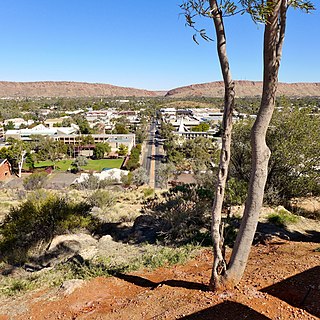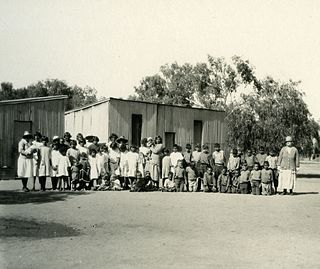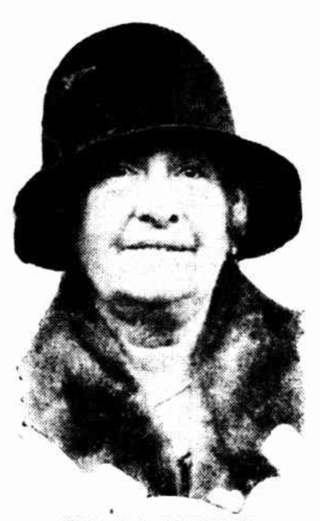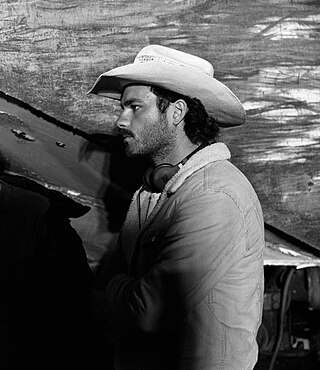
Alice Springs is a town in the Northern Territory, Australia; it is the third-largest settlement after Darwin and Palmerston. The name Alice Springs was given by surveyor William Whitfield Mills after Alice, Lady Todd, wife of the telegraph pioneer Sir Charles Todd. Known colloquially as The Alice or simply Alice, the town is situated roughly in Australia's geographic centre. It is nearly equidistant from Adelaide and Darwin.
The Central Australian Aboriginal Media Association (CAAMA) is an organisation founded in 1980 to expose Aboriginal music and culture to the rest of Australia. It started with 8KIN-FM, the first Aboriginal radio station in the country. Based in Alice Springs, the organisation is particularly focused on the involvement of the local Indigenous community in its production. CAAMA is involved in radio, television and recorded music.
Imparja Television (IMP) is an independent Australian television station servicing over 3,600,000 km2 (1,400,000 sq mi), across six states and territories: Northern Territory, South Australia, Queensland, New South Wales, Victoria, and Tasmania. It is based in Alice Springs, and is controlled by Aboriginal people through ownership by Imparja Television Pty Ltd.
Robert James Randall, also known as Uncle Bob, was an Aboriginal Australian elder, singer and community leader. He was a member of the Stolen Generations and became an elder of the Yankunytjatjara people from Central Australia. He was the 1999 NAIDOC Person of the Year. He is known for his 1970 song, "My Brown Skin Baby ".
Herbert Patrick Laughton, was a country singer from Alice Springs in the Northern Territory of Australia. He is also a member of the Stolen Generations.

Warwick Thornton is an Australian film director, screenwriter, and cinematographer. His debut feature film Samson and Delilah won the Caméra d'Or at the 2009 Cannes Film Festival and the award for Best Film at the Asia Pacific Screen Awards. He also won the Asia Pacific Screen Award for Best Film in 2017 for Sweet Country.
Glynn is a surname. Notable people with the surname include:

The Bungalow was an institution for Aboriginal children established in 1914 in Alice Springs in the Northern Territory of Australia. It existed at several locations in Alice Springs, Jay Creek and the Alice Springs Telegraph Station.
Rona Ellen Glynn, also known briefly as Rona Schaber after marriage, was the first Indigenous Australian school teacher and nurse in Alice Springs in the Northern Territory. In 1965 she became the first Aboriginal woman to have a pre-school named in her honour in Australia.

Topsy Smith was an Arabana pioneer of Central Australia in the Northern Territory. She spent her life caring for Indigenous children at an institution known as The Bungalow in Alice Springs.
Priscilla "Cilla" Atkins, is a prominent Aboriginal leader, advocate and television producer. Atkins was the Chief Executive Officer of the North Australian Aboriginal Justice Agency (NAAJA), the largest law firm in the Northern Territory of Australia.

Ida Standley was the first school teacher in Alice Springs, Australia. For 15 years, from 1914 to 1929, she worked at The Bungalow. Standley was appointed MBE for her services to children's welfare.
St. Mary's Hostel, formerly Mount Blatherskite Hostel (1946–47), commonly known simply as St Mary's, was an Australian Board of Missions hostel in Alice Springs from 1947 to 1972. Its residents were mostly Aboriginal children, including some who were taken as wards of the state because they were half-caste. In 1972, coming under new management, it was renamed St Mary's Children's Village (1972–1980).
Erica Glynn is an Indigenous Australian filmmaker, known for directing, producing and writing documentaries and other films.
Beck Cole is an Australian filmmaker of the Warramungu and Luritja nations. She is known for her work on numerous TV series, including First Australians, Grace Beside Me, Black Comedy and Wentworth, as well as documentaries and short films. She is based in Alice Springs, in the Northern Territory.
Danielle MacLean is an Australian filmmaker. She is known for her writing on television series such as Little J & Big Cuz, 8MMM Aboriginal Radio and Redfern Now.

Dylan River is an Australian film director, writer, and cinematographer.
Steven McGregor is an Australian filmmaker, known for his work on Redfern Now, Black Comedy, Sweet Country, and numerous documentaries, including My Brother Vinnie.
David Jowsey is an Australian film producer, co-founder of Bunya Productions. He is known for producing many films made by Indigenous Australian filmmakers. Bunya Productions' co-owners are Indigenous filmmaker Ivan Sen, and Jowsey's wife Greer Simpkin.
Woodgreen Station, also spelt Wood Green and also known as Atartinga, is a cattle station located in the Northern Territory of Australia, to the northeast of Alice Springs, extending approximately 2,215 km2 (855 sq mi). It was also known as (Mer) Athatheng by some of the Indigenous people in the area.






